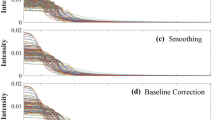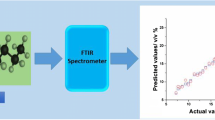Abstract
An objective method based on partial least-squares discriminant analysis (PLS-DA) was used to assign an oil lump collected on the coastline to a suspected source. The approach is an add-on to current US and European oil fingerprinting standard procedures that are based on lengthy and rather subjective visual comparison of chromatograms. The procedure required an initial variable selection step using the selectivity ratio index (SRI) followed by a PLS-DA model. From the model, a “matching decision diagram” was established that yielded the four possible decisions that may arise from standard procedures (i.e., match, non-match, probable match, and inconclusive). The decision diagram included two limits, one derived from the Q-residuals of the samples of the target class and the other derived from the predicted y of the PLS model. The method was used classify 45 oil lumps collected on the Galician coast after the Prestige wreckage. The results compared satisfactorily with those from the standard methods.




Similar content being viewed by others
References
Bentz AP (1976) Oil Spill Identification. Anal Chem 48(6):454A–472A
US Coast Guard (1977) Oil Spill Identification System. USCG Report No (X-D-52-77, Task No 4243.2
Boehm PD, Douglas GS, Burns WA, Mankiewicz PJ, Page DS, Bence AE (1997) Application of petroleum hydrocarbon chemical fingerprinting and allocation techniques after the Exxon Valdez oil spill. Mar Poll Bull 34(8):599–613
Christensen JH, Hansen AB, Tomasi G, Mortensen J, Andersen O (2004) Integrated methodology for forensic oil spill identification. Environ Sci Technol 38(10):2912–2918
Douglas GS, Bence AE, Prince RC, McMillen SJ, Butler EL (1996) Environmental stability of selected petroleum hydrocarbon source and weathering ratios. Environ Sci Technol 30(7):2332–2339
Fernández-Varela R, Gómez-Carracedo MP, Ballabio D, Andrade JM, Consonni V, Todeschini R (2010) Self Organizing Maps for Analysis of Polycyclic Aromatic Hydrocarbons 3-Way Data from Spilled Oils. Anal Chem 82(10):4264–4271
Wang Z, Stout SA (2007) Oil Spill environmental forensics: fingerprinting and source identification. Academic Press, United States of America
Wang Z, Fingas M, Sergy G (1994) Study of 22-year-old Arrow oil samples using biomarker compounds by GC–MS. Environ Sci Technol 28(9):1733–1746
Wang Z, Fingas M, Page DS (1999) Oil Spill Identification. J Chromatogr A 843(1–2):369–411
Wang Z, Fingas MF (2003) Development of oil hydrocarbon fingerprinting and identification techniques. Mar Pollut Bull 47(9–12):423–452
Nordtest Method NT CHEM 001 (1991) Oil Spill Identification, 2nd Edition
Daling PS, Faksness LG (2001) Laboratory and reporting instructions for the CEN/BT/TF 120 Oil Spill Identification Round Robin Test. Technical report, SINTEF report STF66 A02027
Fasksness LG, Weiss H, Dailing PS (2002) Revision of the Nordtest methodology for oil spill identification. Technical Report, SINTEF Report STF66 A02028
EUROCRUDE® (1995) European Crude Oil Identification System Final Report
CEN/TR 15522–2 (2006) Oil Spill identification, Waterborne petroleum and petroleum products, Part 2: Analytical methodology and interpretation of results. Technical report
ASTM D3328–06 (2006) Standard Test Methods for Comparison of Waterborne Petroleum Oils by Gas Chromatography. ASTM International, West Conshohocken, PA
ASTM D5739–06 (2006) Standard Practice for Oil Spill Source Identification by Gas Chromatography and Positive Ion Electron Impact Low Resolution Mass Spectrometry. ASTM International, West Conshohocken, PA
Method 8015B (1996) Total petroleum hydrocarbons (TPH) as Gasoline and Diesel. US-EPA SW-846, Revision 2
Method 8270D (2007) Semivolatile organic compounds by gas chromatography/mass spectrometry (GC/MS). US-EPA SW-846, Revision 4
Snape I, Harvey PMcA, Ferguson SH, Rayner JL, Revill AT (2005) Investigation of evaporation and biodegradation of fuel spills in Antarctica I A chemical approach using GC–FID. Chemosphere 61(10):1485–1494
Snape I, Ferguson SH, Harvey P, McA RMJ (2006) Investigation of evaporation and biodegradation of fuel spills in Antarctica: II – Extent of natural attenuation at Casey Station. Chemosphere 63(1):89–98
Lucas Z, MacGregor C (2006) Characterization and source of oil contamination on the beaches and seabird copses, Sable Island, Nova Scotia, 1996–2005. Mar Pollut Bull 52(7):778–789
Christensen JH, Hansen AB, Karlson U, Mortensen J, Andersen O (2005) Multivariate statistical methods for evaluating biodegradation of mineral oil. J Chromatogr A1090(1–2):133–145
González JJ, Viñas L, Franco MA, Fumega J, Soriano JA, Grueiro G, Muniategui S, López-Mahía P, Prada D, Bayona JM, Alzaga R, Albaigés J (2006) Spatial and temporal distribution of dissolved/dispersed aromatic hydrocarbons in seawater in the area affected by the Prestige oil spill. Mar Pollut Bull 53(5–7):250–259
Franco MA, Viñas L, Soriano JA, de Armas D, González JJ, Beiras R, Salas N, Bayona JM, Albaigés J (2006) Spatial distribution and ecotoxicity of petroleum hydrocarbons in sediments from the Galicia continental shelf (NW Spain) after the Prestige oil spill. Mar Pollut Bull 53(5–7):260–271
Ebrahimi D, Brynn Hibbert D (2008) Identification of sources of diesel oil spills using parallel factor analysis: A bridge between American society for testing and materials and Nordtest methods. J Chromatogr A 1198–1199:181–187
Sun P, Bao M, Li G, Wang X, Zhao Y, Zhou Q, Cao L (2009) Fingerprinting and source identification of an oil spill in China Bohai Sea by gas chromatography–flame ionization detection and gas chromatography – mass spectrometry coupled with multi-statistical analyses. J Chromatogr A 1216(5):830–836
Pasadakis N, Gidarakos E, Kanellopoulou G, Spanoudakis N (2008) Identifying Sources of Oil Spills in a Refinery by Gas Chromatography and Chemometrics: A Case Study. Environ Forensics 9(1):33–39
Lavine BK, Brzozowski D, Moores AJ, Davidson CE, Mayfield HT (2001) Genetic algorithm for fuel spill identification. Anal Chim Acta 437(2):233–246
Doble Ph, Sandercock M, Du Pasquier E, Petocz P, Roux C, Dawson M (2003) Classification of Premium and regular gasoline by gas chromatography/mass spectrometry, principal component analysis and artificial neural networks. Forensic Sci Int 132(1):26–39
Urdal K, Vogt NB, Sporstøl SP, Lichtenthaler RG, Mostad H, Kolset K, Nordenson S, Esbensen K (1986) Classification of Weathered Crude Oils Using Multimethod Chemical Analysis, Statistical Methods and SIMCA Pattern Recognition. Mar Pollut Bull 17(8):366–373
Gaines RB, Hall GJ, Frysinger GS, Grondlund WR, Juaire KL (2006) Chemometric Determination of Target Compounds Used to Fingerprint Unweathered Diesel Fuels. Environ Forensics 7(1):77–87
Fonseca AM, Biscaya JL, Aires-de-Sousa J, Lobo AM (2006) Geographical classification of crude oils by Kohonen self-organizing maps. Anal Chim Acta 556(2):374–382
Borges C, Gómez-Carracedo MP, Andrade JM, Duarte MF, Biscaya JL, Aires-de-Sousa J (2010) Geographical classification of weathered crude oil samples with unsupervised self-organizing maps and a consensus criterion. Chemom Intell Lab Syst 101(1):43–55
Fernández-Varela R, Andrade JM, Muniategui S, Prada D, Ramírez-Villalobos F (2010) Identification of petroleum hydrocarbons using a reduced number of PAHs selected by Procrustes. Mar Pollut Bull 60(4):526–535
Grueiro-Noche G, Andrade JM, Muniategui-Lorenzo S, López-Mahía P, Prada-Rodríguez D (2010) 3-Way pattern-recognition of PAHs from Galicia (NW Spain) seawater simples after the Prestige’s wreck. Environ Pollut 158(1):207–214
Christensen JH, Hansen AB, Mortensen J, Andersen O (2005) Characterization and Matching of Oil Samples Using Fluorescence Spectroscopy and Parallel Factor Analysis. Anal Chem 7(77):2210–2217
Arancibia JA, Boschetti CE, Olivieri AC, Escandar GM (2008) Screening of oil samples on the basis of excitation–emission room-temperature phosphorescence data and multi-way chemometric techniques. Introducing the second-order advantage in a classification study. Anal Chem 8(80):2789–2798
Zorzetti BM, Harynuk JJ (2011) Using GC × GC–FID profiles to estimate the age of weathered gasoline samples. Anal Bioanal Chem 401(8):2423–2431
Lobão MM, Cardoso JN, Mello MR, Brooks PW, Lopes CC, Lopes RSC (2010) Identification of source of a marine oil-spill using geochemical and chemometric techniques. Mar Pollut Bull 60(12):2263–2274
Fernández-Varela R, Andrade JM, Muniategui S, Prada D, Ramírez-Villalobos F (2009) The comparison of two heavy fuel Oils in composition and weathering pattern, based on IR, GC–FID and GC–MS analyses: Application to the Prestige wreckage. Water Res 43(4):1015–1026
Cozzolino D, Chree A, Scaife JR, Murray I (2005) Usefulness of Near-Infrared Reflectance (NIR) Spectroscopy and Chemometrics to Discriminate Fishmeal Batches Made with Different Fish Species. J Agric Food Chem 53(11):4459–4463
Bishop CM (2006) Pattern Recognition and Machine Learning. Springer, New York
Wise BM, Gallagher N B, Bro R, Shaver JM, Windig W, Koch RS (2005) PLS-Toolbox Version 3.5 for use with MATLABTM, Eigenvector Research, Inc., Manson, WA, USA
Duda RO, Hart PE, Stork DG (2001) Pattern Classification, 2nd edn. John Wiley & Sons, Inc., New York, NY
Sánchez MS, de la Cruz Ortiz M, Sarabia LA, Busto V (2010) Class-modelling techniques that optimize the probabilities of false noncompliance and false compliance. Chemom Intell Lab Syst 103(1):25–42
Brereton RG (2006) Consequences of sample size, variable selection, and model validation and optimization, for predicting classification ability from analytical data. Trends Anal Chem 25(11):1103–1111
Rajalahti T, Arneberg R, Berven FS, Myhr K-M, Ulvik RJ, Kvalheim OM (2009) Biomarker discovery in mass spectral profiles by means of selectivity ratio plot. Chemom Intell Lab Syst 95(1):35–48
Rajalahti T, Arneberg R, Kroksveen AC, Berle M, Myhr D-M, Kvalheim OM (2009) Discriminating variable test and selectivity ratio plot: Quantitative tools for interpretation and variable (biomarker) selection in complex spectral or chromatographic profiles. Anal Chem 81(7):2581–2590
Sinkov NA, Johnston BM, Sandercock PML, Harynuk JJ (2011) Automated optimization and construction of chemometric models based on highly variable raw chromatographic data. Anal Chim Acta 697:8–15
Johnson KJ, Wright BW, Jarman KH, Synovec RE (2003) High-speed peak matching algorithm for retention time alignment of gas chromatographic data for chemometric analysis. J Chromatogr A 996:141–155
Acknowledgments
M.P.G-C acknowledges the Galician Government (Xunta de Galicia) for a postdoctoral “Ángeles Alvariño” Research Contract and a post-doc grant partially supported by the EU FEDER funds to stay at the URV. The Research Grant 07MDS031103PR (Xunta de Galicia) is recognized.
Author information
Authors and Affiliations
Corresponding author
Electronic supplementary material
Below is the link to the electronic supplementary material.
ESM 1
(PDF 120 kb)
Rights and permissions
About this article
Cite this article
Gómez-Carracedo, M.P., Ferré, J., Andrade, J.M. et al. Objective chemical fingerprinting of oil spills by partial least-squares discriminant analysis. Anal Bioanal Chem 403, 2027–2037 (2012). https://doi.org/10.1007/s00216-012-6008-5
Received:
Revised:
Accepted:
Published:
Issue Date:
DOI: https://doi.org/10.1007/s00216-012-6008-5




